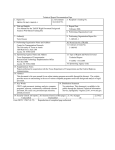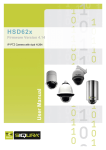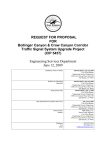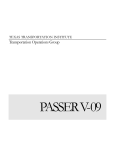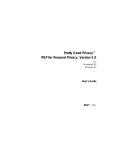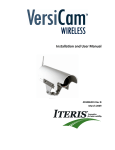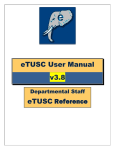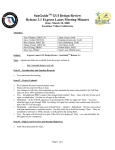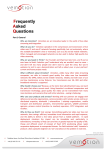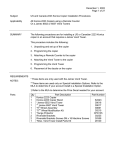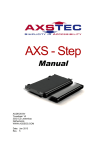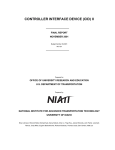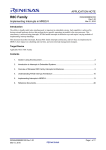Download Special Specification Template
Transcript
1993 Specifications CSJ 0914-33-036, Etc. SPECIAL SPECIFICATION 3443 Distributed Traffic Control System 1. Description. This Item governs the minimum requirements for a distributed traffic responsive traffic signal control system consisting of all labor, supplies, equipment, and services necessary to provide the operation and functions described herein. Provide an Advanced Traffic Management System (ATMS) with the capability of selecting and implementing traffic signal timing plans based on real-time traffic conditions, preset time events, and operator commands. Design the system using a “building-block” design which enables future system expansion to its maximum capacity without major modifications to the central control system. The system configuration consists of three principal elements, namely, the local controller assembly, the spread-spectrum radio communications link, and the distributed traffic control system. The local controller assembly and the spread-spectrum radio communications requirements will be furnished to the Contractor. The functional requirements of the distributed traffic control system are described herein. The Contractor is responsible for integrating the local controller assembly, communications subsystem, and the ATMS software. 2. Materials. (1) Required Features and Functionality. The following sections provided the minimum requirements for the new ATMS. (2) Central Office Hardware Requirements. (a) LAN Hardware. Provide all necessary LAN hardware to connect servers, workstations, printers, and other auxiliary devices in a manner that ensures reliability and the ability to accommodate future expansion. Provide serial multi-port concentrators as required to connect devices such as dialup modems for remote access, a WWV or GPS clock, or a display wall controller. Provide all necessary bridges to link LANs at different geographic locations (i.e., traffic management centers, traffic signal shops, area offices, etc.). Provide and install firewall software and hardware to meet security needs. (b) Printers. 1-28 3443 05-05 Report Printer. At least one laser printer shall be provided that shall be accessible from all central operator workstations. The printer shall provide at least 10 pages per minute output at 600 dpi and shall accommodate at least 250 sheets of paper simultaneously in the paper tray. Log Printer. One standard-width dot matrix line printer shall be provided for logging system events. (3) System Capacity. (a) Provide a system with capacity for an unlimited number of intersections, on-street masters, and control groups. (b) Allow up to 32 devices per communications channel. (c) Communicate with all equipment periodically to monitor status. (d) Allow handling of extended monitoring and upload/download requests concurrently (e) Provide a system that supports all of the following communications media: • 1200 baud, 2- or 4-wire, half-duplex, TDM/FSK via twisted pair or telephone line • 1200-19,200 baud single or multi-mode fiber optic • 1200-19,200 baud CATV • 1200-19,200 baud fixed or spread spectrum radio • 1200-19,200 baud private coaxial cable (f) Support the use of multiple media simultaneously. (4) Graphical User Interface. (a) Design the ATMS graphical user interface (GUI) software so that it provides the operator with a graphical operating environment of the type commonly found on today's desktop computers. (b) Supply a GUI that is easy to use while providing a fast and efficient way to control and monitor the ATMS. (c) Provide a GUI that allows the operator to intuitively select objects on the screen by point-and-click manipulation with the mouse, thereby minimizing typing and the need to memorize lengthy commands. (d) Provide hot keys for commonly used functions. Incorporate the following into the GUI: • pop-up multiple display objects and windows, • menu icons and controls, • dialog boxes, 2-28 3443 05-05 • rollovers with automatic pop-ups, • push button and other active commands, • visual and audio alarms, and • use of object characteristics such as colors, highlighting, and flashing to alert operators of status changes. (e) Orient the GUI interface around graphic tools based on the principle of direct manipulation. Several windows may be active at the same time and may overlap on the screen. (f) Allow the operator to easily switch from one window to another, such as by pointing with the mouse cursor to the uncovered part of another window. (g) Allow the operator to move any window on the screen, to change window size, and to collapse a window to an icon. (h) When an exception condition (such as a device failure) exists, provide an inactive window that attracts the operator's attention by beeping and/or flashing its icon or title bar. (5) System Access. (a) Multi-user Access Required. Furnish an operating system and ATMS software that supports a multi-terminal, multi-user interface. Provide ATMS software that allows access to multiple levels of the system simultaneously. Design the system so that a minimum of 6 users, each one of who can be assigned a specific level of access privilege, are able to access the system concurrently. (b) Multiple Port Servers. Provide a system that supports multiple field communications servers to communicate with traffic devices. Allow additional servers that may be the same as the central sever, or separate as required. Design the system so that if a separate communications server is desired, it can be connected via a high-speed LAN (10/100 or faster) to the central server. Only use servers that are PC based, running Windows NT/2000. Provide a system that supports a sufficient number of user workstations. (c) System Security. Provide and maintain a security system for the ATMS software that prevents unauthorized access to the system. This applies to executable files as well as text and database files. 3-28 3443 05-05 Design the system to define operator privileges on a functional level. Provide each operator with a privilege level mask defined for him/her by the system administrator. Use this mask to define the specific functions that the particular operator is authorized to perform. For example, a particular operator may be given the ability to view all reports, but not to modify some or all levels of the database. Allow for any number of different levels of operator access capability. Provide the system administrator level with full access to the system as well as the responsibility for maintaining account passwords and privilege level masks. Require the operator to enter an operator identification code before gaining access to the ATMS. Design the ATMS software to validate the code against an encrypted database of authorized operators. Only allow the execution of a session start-up procedure after successful completion of the log-in. Provide a start-up procedure that establishes the privileges, object menu options, windows, and tools the operator may utilize. Gray out or hide any functions that a particular operator is not authorized to access so that the operator can easily distinguish the functions to which he or she has access. Limit LAN access to those activities that support the ATMS. Restrict or eliminate any activity that hinders or does not directly support the operation of the ATMS. Eliminate any executable files that are not needed in support of the ATMS from the system or otherwise protect them from access, thus minimizing any risk associated with unauthorized access. Eliminate any operating system tasks that impede system response (i.e. clock, calendar manager, file manager, etc.). Log all unsuccessful log-in attempts to the system log. (d) Remote Access. Provide ATMS software with the capability of providing access to the system for remote operators, including workstations which are physically connected to the LAN as well as computers connected by dial-up telephone modem or the internet. Allow concurrent operation of all connected computers, including those connected remotely. Allow the system administrator to reduce the access capabilities of operators while they are logged into the ATMS software from a remote computer. For example, someone who would normally have full access privileges while inside the TMC might be granted lesser capabilities if using a computer connected by means of dial-in modem. (e) Remote Computer Software. 4-28 3443 05-05 Furnish a version of ATMS software that runs on portable computers. Allow portable computer users to have the same command and monitoring functions available to operators within the TMC. Provide dial-in security features in the ATMS designed to protect the system from unauthorized access by computer hackers capable of breaking sign-on password protection. It is acceptable for remote-access computers to have a scaled down version of the graphics capability. For example, generic intersection graphics would be acceptable at a remote computer even though a precise graphical file may be available within the ATMS graphic database. Include any generic graphics files on the remote computer. Design the system so that all other database items reside only on the ATMS central software. Allow remote computers to monitor operations of a minimum of 6 intersections. (f) Direct-Connect Access to Local Controllers. Furnish portable computer software that enables a portable computer to be connected directly to the local intersection controller. This will provide field technicians with the ability to access and modify the local controller database without directly accessing the ATMS central software. Allow field technicians to directly upload or download controller timing parameters and to set the time and date of the local controller. Provide field technicians with remote access to the ATMS by means of a dial-up connection. Design this function to allow the technician: • to download the current ATMS parameters for any controller to a controller or portable computer, and • to upload newly established local controller parameters to the ATMS. (g) Automatic Paging. Furnish ATMS software with the capability of automatically sending alphanumeric messages to pagers. Provide a paging function that will maintain a database of at least 100 system event messages and at least 500 physical cross street addresses of devices. Send an alarm to the pager of a designated operator upon detection of a critical event. Furnish a fully programmable pager feature, allowing designation of those events which will trigger a page, the operator to be paged by time-of-day, day-ofweek (TOD/DOW), and alternate operators to be paged in sequence until confirmation is received or the alarm is acknowledged. If the operator to be 5-28 3443 05-05 paged is logged onto the system at the time of the critical event, a general alarm to that operator will be initiated instead of a page. Design the TOD/DOW function so that specified events are allowed to initiate a page only during a specified time frame. Furnish a call back confirmation function with the paging system to assure that the call was received. If the confirmation does not occur, design the paging system to call alternate operators in sequence until confirmation occurs or the alarm is acknowledged. Allow the operator to enable/disable individual paging functions remotely by portable computer or phone keypad. Log all such actions onto the system log. (6) Time/Date Synchronization. (a) Synchronization with Universal Time. Provide the means by which the system's central time clock is automatically synchronized with universal time, either through the WWV radio broadcast or by other approved means, at least once per hour. Allow the operator to disable and re-enable this function. (b) System-wide Clock Updates. Provide for the automatic downloading of clock updates to each field clock. Allow the frequency of such updates to be operator-programmable within a minimum range of once per day to once per minute. Unless the feature has been disabled by the operator, transmit a clock update in conjunction with the command for implementation of a different timing plan. (c) Verification of Field Clocks. Upload, on a periodic basis selectable by the operator, the date/time from local controller and other field clock. If the time/date in the field clock has drifted beyond an operator-defined amount, then: • automatically download the true time to the field clock, or • report the clock drift to the operator. Log the event and action taken. (d) Accommodation of Daylight Savings Time, Leap Year, etc. Provide ATMS software with the ability to enable or disable daylight savings functions and handle leap years. (7) Control Modes. 6-28 3443 05-05 (a) General. Operate the ATMS software in a distributed mode, fully making use of the intelligence in the local intersection controllers. Program the intelligent local controllers with timing plans, time-of-day/day-ofweek (TOD/DOW) schedules, and all other parameters required to operate the local intersection. Monitor all intersection controllers on a user-selectable basis, ranging from once per second to once per minute, through the ATMS software. Upon system startup, establish communications with all intersection controllers and begin real-time monitoring. Start to process both incoming data and operator requests. Any upload, download, or time or date requests takes precedence over real-time monitoring. Design the ATMS for unattended operation 24 hours per day, seven days a week, without requiring an operator to be logged into the system. Provide system control by coordinating intersection operation on an individual, section, or system-wide basis. Include in the software, as a minimum, the following control modes, which shall be operator-selectable from the GUI. • Manual Control • Time-Of-Day/Day-Of-Week Control • Free Operation/Remote Flash Mode • Traffic Incident Responsive Always use local TOD/DOW upon system startup. If the event scheduler is calling for traffic responsive mode at the time of system restart, transfer the system to traffic-responsive mode after an operator-selectable amount of time. Allow for commanding an intersection to a timing plan different than the TOD/DOW, either by manual override or through the traffic-responsive algorithm. Revert back to local TOD/DOW schedule in the event that, while in software-commanded override, a controller does not receive a valid timing plan number from the ATMS software within an operator-defined time frame. Allow the central override function on an intersection, section, or system-wide basis. (b) Manual Control. Allow the operator to invoke manual override of the plan currently in effect for the entire system, for a subsection of the system, or for individual intersections. Give manual selection of timing plans a higher priority than all other modes of timing plan selection. Provide the operator with the following 2 options for implementing manual override: 7-28 3443 05-05 • setting the manual override and later releasing the override manually, or • setting the manual override with a specified time frame for automatic termination. Under the second option, terminate the manual override automatically at the end of the specified time. When manual override is terminated, revert each affected controller to its previous mode of operation. (c) Time-Of-Day/Day-Of-Week Control. Use the TOD/DOW mode for controlling traffic conditions that occur regularly. In this mode, have each controller automatically select and implement traffic signal timing plans in accordance with the defined schedule, locally stored, on a TOD/DOW basis. Allow TOD/DOW plans to be downloadable from the ATMS software to the controller in the field. Limit the number of timing plans available in the ATMS database only by the amount of disk space available. Allow any plan located at the ATMS to be downloaded to any slot in the local controller's database. Tag the timing plans that are being stored in the local controller in the ATMS database so that the ATMS software always knows which plans are stored at the controller. In order to download a timing plan to a controller, allow the operator to select the plan from the ATMS database and the controller memory slot where the plan will reside. Provide a user interface that allows the operator to choose timing plans for all available memory slots at once. Enable the operator to initiate one download per controller to download all timing plans and time-of-day events. (d) Free Operation/Remote Flash Mode. In the free mode, run the local controller uncoordinated. To initiate flashing operation remotely, allow the controller to be commanded to flash from the ATMS software. (e) Traffic Incident Responsive. This mode allows the system to dynamically react to current street conditions. The minimum functional requirements for a Traffic Incident Responsive system are listed below: Provide the user with a selectable series of commands, referred to as the activation response, coupled with a Boolean statement comprised of up to six logically connected (with and/or operators) conditions referred to as the trigger. When 8-28 3443 05-05 the entire logic statement (trigger) is true, execute the associated activation response. The trigger definition and activation response together is termed an event. Provide a user-selected minimum duration time and disable time for a traffic incident. The minimum duration time is the minimum time the event must remain active unless manually disabled by the user. The disable time is the minimum time the event must remain inactive following deactivation before it may be reactivated, unless the user either manually reactivates the event or modifies the trigger or response. After an event, provide a user selectable deactivation response schedule, which is a series of commands to be executed upon deactivation of the activation response. Conditions comprising the trigger may include time-of-day; volume, occupancy, or speed on a specified detector; intersection or system status; special function on/off; external command; or even another trigger. Record actual event activation and deactivation, user abort and activation errors in the System log. Design the system to warn the user of conflicting activation response files, allowing the user to define conditions to alleviate the problem. Allow Traffic Incident response events to be enabled or disabled by the user. A disabled event is one not eligible for execution even if its trigger condition is satisfied. (8) Signal Timing Plan Implementation and Monitoring. (a) Control Sections (Subsystems). Enable the operator to define a minimum of 100 control sections, or subsystems, each of which can be completely independent of the connection of any particular intersection to the communications network. Allow the number of intersections in a particular subsystem to be programmable from a minimum of one to a maximum of the total number of intersections in the system. Allow intersections and detectors to be assigned to different sections by time of day, either by operator command or through the event scheduler. (b) Local Intersection Control and Control Modes. Provide local traffic signal control functions by the local controller firmware. Use the intersection controller to determine the coordination cycle synchronization point from the current time-of-day. Determine all offset, split, and transition timings and implement them locally. Follow the local controller TOD/DOW schedule under normal operation. 9-28 3443 05-05 Download timing plans, if required, and command intersections to that plan by sending a plan number to the controller when an operator or the ATMS software determines that a different timing plan should be implemented. If communication is lost between the intersection and the ATMS software, revert back to the intersection’s original TOD/DOW schedule. Do not allow a downloaded special plan to overwrite any plans that are used by the TOD/DOW schedule. Allow the operator to select controller timing plan slots to be used as temporary locations and the remaining slots for TOD/DOW usage. (c) Number of Timing Plans Required. Design the ATMS to provide for a minimum of 16 timing plans for each intersection to be stored in the central database. At any one time, provide for a minimum of 12 of these plans to be stored in the local controller's database and implemented upon command by the new ATMS. Provide a minimum of 6 available cycles. For each timing plan, include uniquely programmable values for cycle length and offset, a uniquely programmable phase sequence, and uniquely programmable split values. Furnish software that provides both the automatic calculation of permissive periods (based on splits values) and the ability for the operator to input desired values for the beginning and end of permissive periods. Provide the capability to handle special signal and/or timing plans to accommodate unusual traffic flow patterns during special events, parades, etc. These special event timing plans may be included within the thirty-two timing plans. (d) Accommodation of Phase Sequences. Provide ATMS software that allows the independent control of each phase of an eight-phase, dual-ring controller. For example, in normal quad-left operation, make it possible to program the force-off for Phase 1 independently from the force-off for Phase 5. Provide for the control of lead-lag phase sequences. In conjunction with each timing plan, enable the independent programming of each odd numbered phase to be either leading or lagging with respect to its associated even numbered phase (i.e.: for each timing plan, make it possible to program the lead-lag status of the 1-2 phase pair independently from that of the 5-6 phase pair, the 3-4 phase pair, and the 7-8 phase). Supply ATMS software that provides for the control of standard three-phase and four-phase (e.g., TTI) diamond interchange phasing. (e) Preemption. 10-28 3443 05-05 Furnish ATMS software that recognizes the occurrence of locally-initiated preemption (emergency vehicle or bus) and thereby not erroneously diagnose a coordination failure because the local controller has been preempted. In addition to local preemption, provide preemption for emergency vehicles along a pre-specified route. To this end, allow a user with the proper authorization to manually implement a timing plan specifically designed for this purpose. (f) Accommodation of Pedestrian Services Which Violate Normal Split Times. At locations where the major street is wide, the cross-street split times (which are based on vehicular needs) may not be long enough to accommodate a pedestrian service. Accordingly, whenever a pedestrian actuation does occur, the intersection will get out of step. Do not allow the ATMS software to fail the intersection as a result of a normal force-off time being exceeded to service a pedestrian call. Such a pedestrian call may be treated as a preemption for the purpose of accomplishing this requirement. (g) Special Functions. Provide the ability to accommodate the control and monitoring of the on/off status of a minimum of 4 special functions to be implemented by the intelligent local controller. (h) Remotely-Requested Download of Local Database. Give signal technicians the ability, from the local controller, to effect a download of the local controller database from the central database without the need for an operator to be present at the TMC. (i) Timing Plan Compliance Monitoring. Monitor each intersection with the ATMS software to ensure that its operation is within proper constraints of the timing plan that is in affect. Through compliance monitoring, detect the following error conditions: • the controller is not using the proper timing plan, • the controller time clock is out of synchronization, • the controller is not sequencing, • the phase sequence is improper, and • phase time compliance. Automatically inhibit monitoring by the ATMS software if feedback is not being received from the controller. (j) Intersection Measures of Effectiveness. Using the ATMS software, collect and store data on intersection measures of efficiency (MOEs). Process and maintain intersection MOE data on a continuous basis to be used for various timing analysis and reporting tasks. Store intersection feedback on a per-phase basis. Store, at a minimum, the following intersection MOEs: 11-28 3443 05-05 • percent of green time used versus split, • percent of detector calls (relative to a threshold value), • number of times the phase maxes out or is forced off prior to gap-out, and • number of pedestrian calls. Automatically record intersection data in the ATMS database and periodically archive the data onto removable optical media. Store up to 4 weeks of intersection data for each intersection on the ATMS database by the database program. If bad data or no data is received from the intersection, tag the data as questionable or not available in the ATMS database. In case of failure during a database write process, do not allow the database program to leave a partially written block. Tag any missing blocks as unavailable. Give the operator the capability to enable or disable data collection on an individual intersection basis. Provide an operator-selectable time increment between writing of data to the optical disk drive and start time, with defaults of 24 hours and midnight, respectively. Automatically compress data when writing to the removable optical media. Date and duration tag each history file using file naming convention. Provide a data storage feature with the ability to append intersection data to the removable optical media, enabling full usage of the media. When the removable optical media does not have enough storage space left for a full time interval of intersection data, have the system notify the operator that a new storage disk is required. Give the operator the ability to enable and disable archiving on an individual intersection basis. Allow intersection data to be retrievable from the removable optical media for use with the relational database and traffic modeling packages. Upon retrieval, automatically expand the intersection data on the optical disk from the compressed format. (9) ATMS Database. (a) Database Generation and Maintenance. Furnish and implement an Engineer-approved, off-the-shelf database package. Provide a database interface, which is integrated into the ATMS software to provide seamless operation for the operator. 12-28 3443 05-05 Provide for off-line and online database generation and maintenance through the resulting combination of ATMS software and database software. Provide a system for loading, modifying, examining, copying, and retrieving the data used to operate the system. These data include traffic system configuration, timing plans, TOD/DOW schedules, operator databases, and alarm databases. Include channel assignments, communication parameters, included intersections, etc. in the traffic system configuration. Allow database changes without having to restart the ATMS software. Design data entry forms for easy data preparation by the operators. Place electronic copies of these forms on each workstation, laptop, and personal data assistant (PDA). For all tables in the database, provide printable, properly formatted tables for use by the traffic engineers and maintenance technicians in the field. Allow the operator to copy data tables for use with other devices in order to alleviate repetitive data entry. Include safeguards in the database generation of traffic control operations to preclude dangerous or undesirable intersection operation. Include, as minimum, range-checking and timing plan verification in the safeguards. (b) Database Recovery. Provide all database backup and recovery through the ATMS software user interface. Allow the operator, as a minimum, to do the following: • automatically compress and back-up the database on an operator-specified time-of-day setting or upon operator command, and • restore the back-up copy of the database to the ATMS database. (c) Database Reports. Allow the operator to generate custom reports using the relational database custom report utility supplied with the database package. Provide a seamless interface to this utility. (10) Reporting Capabilities. (a) General. Allow the reporting capability and monitor screen displays shall to obtainable from the same menu options. Allow the operator to click on a menu of report names and choose the display to be shown on the monitor screen. Allow the operator to print any of these screens to any network printer or to a file at any time during the process by simply clicking a button on the report screen. If 13-28 3443 05-05 sending to the printer, reformat the text as necessary in order to produce a legible printout. Do not print unnecessary information. Approval of all report formats must be obtained from TxDOT. Unless noted below, make the displays/reports available system-wide, by section, by channel, or by single device. (b) Types of Reports Required. As a minimum, provide the following displays/reports: System Status. Provide a display with an overview of the present condition of all devices in the traffic system. Include, as a minimum, intersection controllers, detectors, communication channels, and other categories of devices. Display all possible status conditions (e.g., on-line, failed, etc.) and modes (e.g., TOD/DOW, On Flash, etc.) as described in this specification. By clicking on a particular category on the system status report, allow the operator to initiate the display of an associated detailed report screen. For example, by clicking on the field which indicates the number of intersections failed, the operator would initiate the display of a detailed screen listing the failed intersections and other details (e.g., time of failure). Real-Time Monitor. Show the request and reply to and from a single intersection. Display the command being sent to an intersection along with the feedback data received back from the intersection. Provide a continuous display until stopped by the operator. Display the data in an easily understood format. Do not display the data in hex format. This display is required on an intersection basis only. Communication Statistics. This display/report shows the communications throughput. Include the number of communication attempts, number of successes, number of failures, and percentage of successful communications per intersection, per channel, and per system. Intersection Operation. This display/report shows the detailed intersection operation in real-time mode. This display is required on an intersection basis only. Detailed Intersection Failure Status. This display/report displays the failure information for all failed intersections. Include, as a minimum, the intersection location, reason for failure, and time of failure. Detailed Detector Failure Status. This display/report displays the failure information for all failed detectors. Include, as a minimum, detector location, reason for failure, and time of failure. (c) Report Output Requirements. Reports and displays may be output to the ATMS operator station monitors or any network printer. Reports and displays may also be requested by remote computers, whether LAN-connected or dial-in. (11) System Log Requirements. 14-28 3443 05-05 (a) Traffic System Log. Record all traffic related messages, by order of occurrence, including: • operational events (including occurrences of local preemption), • traffic device failures/repairs, • communication failures/repairs, • traffic data transfer messages, • manual override changes, and • operator log-on and log-off. Unless printing has been suppressed by the operator, automatically output all log messages to a designated printer. Allow the operator to filter which messages are logged to the printer and to suppress all log output to a printer. Maintain an on-line file of all log messages, with all messages logged to the on-line file. This file shall be of fixed length and circular format, overwriting at the beginning when reaching the end of the file. (b) Log of Current Operators. Maintain a continuous record in the ATMS software of the operators who are currently logged onto the system. Add to this log any operator who logs onto the system and, upon log-off, delete the name of that operator from the log. (c) Operating System Log. Log all central system related events that occur in order of occurrence, including: • internal system errors, • system hardware failures, • system network errors, and • software fatal errors. Unless its printing has been suppressed by the operator, automatically output all log messages to a designated printer. Maintain an on-line file of all log messages. This file shall be of fixed length and circular format, overwriting at the beginning when reaching the end of the file. (12) Graphic Display Subsystem (GDS). (a) General. Provide a Graphical Display System (GDS) following the same graphical user interface guidelines as the ATMS software. Design the system so that the interface to the GDS is an integrated module of the ATMS software. 15-28 3443 05-05 Make all commands for manipulating the GDS available directly from the ATMS user interface. Conduct all graphic file generation within the ATMS. Automatically update any remotely stored graphic files by the system. Provide a graphic system with a base map that covers the entire extent of the City limits. Use a TxDOT or City-furnished CAD or GIS-generated graphic file as a static background map. Incorporate the dynamic layers of the GDS onto the base map. As a minimum, the base map will show the roadway centerlines of arterials and collector streets, freeway centerlines, rail lines, and major landmarks. (b) Pan/Zoom Requirements. It is desired that the dynamic mapping provided by the Contractor have full pan/zoom capability. Allow the operator to set up both dynamic and static informational layers that are displayed at different view scale levels by defining the view scale levels in a zoom level set-up configuration database table. By setting up the zoom scale range and appropriately enabled or disabled layers, allow the operator to control which layers display at different zoom scales. For example, at the citywide scale level the operator might enable roadway centerlines (static information) as well as a communication status indication (dynamic information) for each intersection controller across the city. When zooming in to a group of intersections (i.e. changing the view scale), the roadway centerlines would be disabled from view and the roadway curb lines would be enabled (become visible), and all phases of all the intersections in the displayed group shall become visible. An alternative which would be considered as meeting the minimum required functionality (in lieu of full zoom capability) would be to provide a minimum of three discrete levels of displays, including: System-wide display, which include the entire City. Include, as a minimum, centerlines of major roadways (including all which include a signal), freeway centerlines, rail lines, and major landmarks. At this level, depict signalized intersections, system detector stations, and other field devices as dynamic symbols (e.g., circles, squares, etc.). Give the operator pan/zoom capability within the system-wide display. Area displays, which include portions of the system-wide display. (An example would be an area display of the central business district.) At this level, roadways may still be depicted as centerlines but all minor streets shall be included. At this level, it shall be possible to view the green status of the coordinated phase green. Give the operator pan/zoom capability within each area display. 16-28 3443 05-05 Intersection displays, which depict roadway curb lines and lane lines and include static displays of the following (as a minimum): street names, intersection number, phase numbering, and special function definition; and North arrow. Dynamic Indicators. As a minimum, include the following dynamic indicators: controller operational mode (e.g., TOD/DOW, traffic responsive, manual, free, or remote flash), controller status (e.g., in transition, preempted, conflict flash, etc.), communications status (e.g., on-line, bad communication, or no communication), timing parameters currently effect (e.g., control mode, transition status, control section assignment, timing plan number, cycle length, offset, and split values), color status of all vehicular phases and overlaps (including the circular red, yellow and green indications and all arrows), color status of all pedestrian phases (including walk, flashing don't walk, and steady don't walk), actuation status of all local detectors (vehicular and pedestrian) and all system detectors associated with the intersection, special function status, count-up of cycle clock, and countdown of the number of seconds remaining for the split of the phase in service. Use common icons as much as possible for all display levels. Allow the operator to select all colors. Use the same colors and icons in display/report screens. Provide a legend within the display window, defining the meaning of each icon and color. If discrete display levels are used in lieu of full zoom capability, provide icons on each level's display to select the view of the other levels. Include a library of standard intersection drawings (e.g., standard four-legged intersection, standard tee intersection, etc.) in the Contractor-furnished software. 17-28 3443 05-05 (c) Graphics Generation. The system-wide base map will evolve from TxDOT or City-furnished databases. Provide a user-friendly utility for import and generation of these graphic images for the GDS. Allow detailed intersection displays representative of AutoCAD-based and Microstation DGN design files to be imported and generated for the GDS. From this graphic generation utility, allow the operator to create and revise all the maps and intersection drawings displayed by the GDS. The actual creation of the graphic displays will be a shared responsibility. The Contractor will develop, as part of the required training: • the system-wide display and demonstrate how it can be edited in the future, • at least one area display and oversee the creation, by TxDOT and/or City staff, of other area displays, • approximately 20 intersection displays (encompassing a range of different intersection types) and • oversee the creation, by TxDOT and/or City staff, of approximately 20 additional intersection displays. The City will create the remaining area and intersection displays. Provide telephonic guidance and support as needed by the City. Supply all custom and commercially available software required for operation and modification of the graphics generation utility package. Supply any additional hardware required for use of the graphics generation utility package. (d) Refresh Rates. As a minimum, refresh all real-time dynamic data displayed on graphic maps as frequently as the feedback data is being returned from the field equipment. If feedback data is not received from the field because of higher priority communication, display a message to the operator of the affected display. Design and develop all static graphic displays in such a way as to ensure instantaneous redraw of the graphic display. This display includes the background map and the real-time feedback data. For example, if the operator pans to the left, the entire screen needs to be redrawn. Draw all displays as quickly as possible. Maximum allowable draw time for the largest map (system-wide) is 2 seconds. Maximum allowable draw time for all other displays is 1 second. (13) Scratch Pad Capability. 18-28 3443 05-05 (a) Provide in the system a method to leave messages electronically on the operator stations for personal reminders or messages to other operators. (b) Make the scratch pad facility available in a separate window integrated with the ATMS interface. (14) System Installation and Failure Recovery. (a) Software Installation. Provide completely automated installation of the ATMS software from storage media. From the operating system command line, do not require more than two typed commands to fully install all required software onto the computers. Once the software is installed, provide configuration screens that allow the system administrator to set distinct operating features of the system. (b) System Startup and Shutdown. Do not require the ability of the ATMS components to interact with each other to be governed by a structured start-up order. That is, if a component fails to operate or is powered down, do not require the remainder of the system to be shut down and restarted to re-establish a working system. The unaffected components should simply wait for the missing component to be returned to the system. When returned, all components should automatically revert to normal operations. Design the system such that it will not need to be shut down if equipment is removed from service or disconnected. If hardware is removed from active duty by power-down or cable-disconnect, report it to be non-responsive by other components of the system. When such equipment is powered up or reconnected, the system should respond by recognizing the return to normalcy and resume regular operations without operator interaction. Include published procedures for accomplishing, in a logical fashion, a complete, system-wide power-down (such as for purposes of moving the system) in the Contractor-furnished documentation. (c) System Failure and Recovery. Signify the beginning and ending of the following system failures by paging appropriate personnel in addition to other reporting requirements detailed below. Power Failure. Configure each lifeline and non-essential component of the ATMS and central communications apparatus with automatic shutdown software which, upon switch-over to UPS, initially allow for up to one minute of blackout before non-essential components begin an automatic shutdown procedure. After 10 minutes of blackout, initiate shutdown procedures for the lifeline communication and ATMS components. When power is restored, return the system to duty automatically. 19-28 3443 05-05 Non-fatal Failure. If the ATMS software detects a non-fatal error within one or more of its processes, alert the operator via an alarm and log a message to the system log. Continue to operate the ATMS in a degraded state. Allow the operator to have final determination on what is considered a non-fatal failure. Fatal Failure. If the ATMS detects a fatal error within one or more of its processes, alert the operator via an alarm and log a message to the system log. Then have the ATMS attempt an orderly shutdown of the system. (15) Software Documentation. Fully document the delivered ATMS software. As a minimum, provide pertinent technical documentation and operator documentation including the following: • proprietary source code escrow option, • database definitions and file structures, • variable descriptions, variable cross-references and subroutine calling sequences, • interface specifications, • requirements traceability matrix, • communication protocols including field device protocol, • security documentation, • system backup and recovery procedures, • system operational procedures and error handling, • hard copy user manual segregated into chapters (or volumes) which group topics according to whether the software is used from TMC operator stations, from remote computers, and from either of the above, • on-line user manual or help facility, • warrantees on software, and • licenses and liens. The Contractor may use different methods for documentation if it provides sufficient information as determined by TxDOT. Submit all documentation to TxDOT for final approval. (16) Testing. (a) System Software Acceptance Test. Subject all software furnished to monitoring and testing to determine conformance with all applicable requirements and to ensure an orderly implementation of the system. Provide a proposed acceptance test procedure to TxDOT for approval at least 30 days before the acceptance test is to begin. Structure the test procedures to exercise each element of the system and to verify the successful implementation of each required feature and element of functionality. 20-28 3443 05-05 Based on the approved procedures, TxDOT in conjunction with the City will perform an extensive test of the delivered software. The contractor is responsible for correcting any problems which may be encountered and resolving any omissions discovered during the software acceptance tests. (b) NTCIP Verification/Testing. Provide test procedures that verify conformance with all of the NTCIP standards and objects identified in this specification. Establish verification by two means. Base each means on written test plans developed by the Contractor and approved by TxDOT, within the parameters described herein. Provide a means of documenting each standard element and a means of indicating its proper operation. For the first means, develop a test plan that incorporates the use of a third party testing suite and/or protocol analyzer to determine if a specific object is transmitted from and can be received by the central software. Require the test suite to determine the value that is being passed and be capable of testing the complete range of values called for in the NTCIP standards and the PICS form completed by the Contractor and submitted as part of his/her proposal. The testing plan must test under conditions that replicate the physical plant (twisted pair copper), subnetwork, transport, application, and information level standards utilized by the central software furnished under this Project. (c) 60-day Observation Period. A 60-calendar day observation period is required. This observation period begins upon successful completion of the system software acceptance test and after all hardware components are operational. The minimum observation period is 60 calendar days. Any major software component deficiency can (negotiable based upon type of failure) reset the calendar to day number 1. Determination of whether the calendar is reset is at the sole discretion of TxDOT. (17) Software and System Operational Training. (a) Provide a minimum of 40 hours of training for TxDOT and/or City personnel on the functional application and operation of the system software supplied. (b) As a minimum, provide the following: • use of operator interface, • use of graphical map generation and animation, • database use and manipulation, • system parameter and database entry, • error messages and troubleshooting techniques, • database custom report generation, • overview of system structure and interfacing, • priority scheme setup, 21-28 3443 05-05 • configuration setup, • system maintenance, • system startup and shutdown, and • system backup and recovery procedures. (c) Include the creation of area and intersection graphic displays in the training. Also include integration of additional intersection/subsystems in to the ATMS. Discuss integration of intersections currently connected directly by direct fiber optic communication links as well as intersections currently connected by dial-up modem communications. (d) Provide both formal classroom presentation and hands-on workshops after full installation of the ATMS and publication of an approved user manual, but before the system software acceptance test procedure. Schedule each training program at the mutual convenience of the Contractor, TxDOT, and the City. Conduct all training during the normal business hours of TxDOT unless specifically noted otherwise. The TxDOT and/or the City reserves the right to videotape any and all training sessions. Present all training courses, lectures, and demonstrations in person by qualified instructors. Conduct the training at a facility provided by TxDOT or the City. Assume, for budget purposes, that the training will be conducted in blocks of not more than 6 hours per day and on not more than 3 consecutive days in any one calendar week. (18) Automatic Detection of Changes in Field Databases. (a) Monitoring of Controller Access. Because field technicians have access to the intersection controllers, there is the opportunity for the local controller database to be changed without such change being commanded from the TMC. It is desired that the local intersection controller report 4 feedback bits (door open, portable computers connected, front panel accessed, and power out) that communicate to the TMC when there is such activity at the controller. Design the ATMS so that, when it detects any of these bits, it automatically responds as follows. • Power Out. Upon restoration of power, log that a power outage occurred and the time at which power was restored. • Door Open. Log that the door is open and when the door returns to a closed position. • Door Open and either the portable computer is connected or the front panel is accessed. Log the event. After door closed signal is received, the ATMS software uploads and compares the local controller's database with the ATMS's central database, which is considered to be the master database. (b) Periodic Upload of Field Databases. Design the ATMS to perform periodic, automatic upload of all field databases and compare such field databases with the ATMS's central database, which is considered to be the master database. (c) Correction of Database Discrepancies. 22-28 3443 05-05 Whenever a discrepancy is discovered between a field database and the ATMS's central database, have the ATMS software initiate one of the two following actions, as defined by the operator: • automatically download the ATMS database, overwriting the local controller, or • alert the operator of discrepancy and allow the operator to choose which parameters to retain in the master database and at the local controller. When comparing field and central database parameters display the two data sets side by side and highlight the discrepancies between the two data sets. Alternately, highlight the discrepancies in the currently displayed database (central or field) and enable the operator to toggle to the other database. Provide the operator with the option of saving the uploaded field database or downloading the central database to the field. (19) Generation and Display of Time-Space Diagrams. (a) Provide a feature in the ATMS software that enables the operator to generate timespace diagrams based on the timing stored in the central database and to display such time-space diagrams on-screen. The operator should then be able to perform on-screen fine-tuning, using click and drag methods to adjust the offsets, with the resulting changes in the widths of the progression bands being displayed. (b) Allow the operator to save to the database the resulting changes in offsets for that timing plan. (c) To fine-tune crossing arterial progression, allow the operator to generate and display the time-space diagram for each street in a separate window. The on-screen adjustment of the offset of the common window should result in changes in the widths of the progression bands in both windows. (20) Automatic Generation of Timing Plans. Provide automatic generation, editing, and downloading of timing plans, including, as a minimum, the following: • a Windows-based analysis package such as Synchro 5.0 (or later version), • the means by which the generated timing plans can be edited on-screen in a manner similar to that described above in Subsection 2.3.4, and • the means by which an edited timing plan can be automatically downloaded to the ATMS database. (21) Graphical Reports. Provide graphical report capability in the ATMS software. As a minimum, provide the following graphic reports: (a) Detector MOE Report. This graphic reports both real-time and archived measure of efficiency (MOE) data and should include the following: present volume versus historical volume, present occupancy versus historical occupancy, and 23-28 3443 05-05 present speed versus historical speed. Time frames for display should be operator-selectable. (b) Intersection MOE Report. This graphic should report both real-time and archived MOE data and include the following: percent of green time used, percent of detector calls (relative to a threshold value), number of max-outs (or force-offs), and number of pedestrian calls. (22) Detailed Graphics Displays. Accommodate the following detailed graphics displays in the system: (a) System-wide Display. Provide a system-wide display that is part of the static base map. At the top level, display all intersections within one window. Allow the operator to configure the different displayable layers along with the displayed map scale that these layers become visible. If real-time information is not available for display at certain top level displays disable the default condition for that layer. Provide the capability of displaying system detector (or link) icons at the area wide level with the GDS software. When the zoom level allows for the display of system detectors, display the data instead of the corresponding link data. Note that when traffic conditions are requested for the area-wide display, base decisions upon link parameters rather than detector parameters. Allow the operator to select the time interval to display the detector data. Allow these data to be displayed in either raw or smoothed form (operator-selectable). Allow the operator to display all detector measures of efficiency (MOEs) available at the area-wide map level. These include volume, occupancy, speed, and delay. Display a legend showing which MOE is being displayed, the time interval and the thresholds that the displayed colors are based on. Allow the operator to specify which MOE is to be displayed and the time interval and thresholds that shall be used for projected averages. Allow a minimum of 4 conditions to be defined as unfavorable, intermediate, favorable, or unknown (i.e. detector failed). Determine the condition by comparing the stored data against the default high and low thresholds set by location and time-of-day. Allow the operator to display detector status. As a minimum, depict the following detector status classifications: • not failed, • no activity, • erratic output, 24-28 3443 05-05 • maximum presence, • failed communication, and • Real-time feedback preempted. (b) Detailed Intersection Display. Allow the operator to display an individual detailed intersection in a window of the traffic display by double clicking on the intersection icon on the overview map at any zoom level. Design the window size to default to one-quarter size of the available display screen size. Allow the operator to change this default. Design the intersection display to depict the intersection in an easy to understand display. Make multiple intersection display windows available for the operator, without restriction to communications channels. Only restrict the number of display windows by the number that can be feasibly displayed on the monitor. Allow the operator to minimize and maximize a detailed intersection display to enable the operator to have multiple displays available. Include all information available for an intersection in intersection displays. Display operator-selectable MOE information on a detailed intersection window. Provide thresholds that are dynamically operator-changeable. Display a legend depicting what MOE is being displayed, the threshold values, and the color definition. If real-time feedback is not available because of higher priority communications, display an appropriate color and/or a message notifying the operator. 3. Documentation. (1) General. (a) Bind all manuals, consisting of minimum 8-1/2 in. x 11 in. pages and 11 in. x 17 in. minimum schematics. (b) Provide operating instructions and maintenance manuals for all Contractorfurnished equipment. Provide four sets of manuals for each item of Contractorfurnished equipment. (c) Submit 4 copies of draft documentation to TxDOT for written approval no later than the delivery of the corresponding Contractor-furnished equipment. (d) Upon written approval by TxDOT, submit final documentation for field hardware prior to the end of the 60-day Observation Period. (2) Computer/Peripheral Hardware (Contractor-furnished). (a) Furnish 4 copies of manuals detailing routine maintenance requirements, troubleshooting procedures, interface drawings and parts lists for each piece of Contractor-furnished equipment. (b) Submit documentation material to TxDOT for review and approval a minimum of 60 days prior to the beginning of the 60-day Observation Period. 25-28 3443 05-05 (3) Computer/LAN/Peripheral Manufacturer Supplied Software. (a) Submit 4 copies of standard documentation for the operating system and all Contractor-furnished computer/LAN/peripheral manufacturer-supplied software. (b) Submit this documentation to TxDOT a minimum of 60 days prior to the start of the 60-day Observation Period. (4) ATMS Software. (a) Submit to TxDOT for written approval, full and complete documentation of the ATMS Software that has been furnished and installed by the Contractor. (b) Prepare and furnish new flow charts and descriptive graphics as necessary, indicating connection to and relationship to existing program modification, additions and changes to the base software and their programs or routines. (c) Supply 4 copies of the traffic control applications software documentation to TxDOT 60 days before the initial applications software test. Until acceptance of the project, the Contractor is responsible for updating the software documentation within 2 weeks of performing any software changes. If the software documentation does not reflect the current software operation, TxDOT may stop all work on the project until the software documentation is updated. Once initially delivered and installed, maintain on-site at all times, on CD-ROM or DVD, one debugged and current backup version of the software. Failure to maintain this documentation is grounds for TxDOT to halt the project until it is provided. The Contractor must demonstrate that source code has been properly escrowed. (d) Prior to acceptance of the project, provide four final ATMS software documentation manuals, two copies of the ATMS software on CD-ROM or DVD, and two copies of program listings. Demonstrate to TxDOT that the backup version of the program on CD-ROM or DVD is debugged and current. This backup version is to remain after acceptance of the project. (5) Color Graphics Subsystem Software. (a) Submit to TxDOT, for written approval, full and complete documentation of the color graphics subsystem software that has been furnished and installed by the Contractor. (b) Prepare and furnish new flow charts and descriptive graphics as necessary, indicating connection to and relationship to existing program modification, additions and changes to the base software and their programs or routines. (c) Prepare and supply complete and fully debugged assembled listings of all source coding provided with and used by the Contractor in the development of this system. (d) Supply 2 copies of the current color graphics subsystem software documentation to TxDOT 30 days before the central hardware is delivered on-site. From the date of initial delivery until acceptance of the project, the Contractor is responsible for updating the software documentation within 2 weeks of performing any software 26-28 3443 05-05 changes. If the software documentation does not reflect the current software operation, TxDOT may stop all work on the project until the software documentation is updated. Maintain on-site, at all times, one debugged and current backup version on CD- ROM or DVD. Failure to maintain this documentation is grounds for TxDOT to halt the project until it is provided. (e) Prior to acceptance of the project, supply to TxDOT three final color graphics subsystem software documentation manuals and two copies of program listings. Demonstrate to TxDOT that the backup version of the program on CD- ROM or DVD is debugged and current. This backup version is to remain after project completion. (6) ATMS User's Manual. (a) Submit 4 copies of the system user's manual for review and approval by TxDOT 60 days prior to the initial acceptance test. These manuals consist of the following two volumes: • Volume 1 - procedures for equipment setup, program loading, operating procedures, operational options, program monitoring, recovery procedures, and error message definition and corrections, and • Volume 2 - procedures for preparing, updating, and troubleshooting the database and pattern histories. (b) Describe in detail the operation of the LANs, file servers, microcomputers, workstations, and peripheral devices with respect to display of program information and parameters, changing of input parameters, and operation of special keys and other equipment. (c) Provide sample output formats as reproductions of laser printer and display outputs. Illustrate the computer information required to provide such a display with the appropriate output format. (d) Provide a complete list of error messages associated with the software operation for both the system operation and the database and pattern history. Define each error message that could appear during system operation as to the actual meaning, cause, and corrective action to be taken. This information is in addition to the basic troubleshooting and malfunction information. (e) Throughout the project, continually update the system user's manual on a monthly basis to reflect the current applications software. Failure by the Contractor to perform this task is grounds for halting work on the project until this task is corrected and demonstrated to the satisfaction of TxDOT. (f) Immediately prior to the acceptance of the project, submit to TxDOT 4 final copies of the system user's manuals. Update these manuals to reflect the current system operation and TxDOT’s comments. TxDOT written approval of the manuals is required before final acceptance is complete. (7) Training Manuals. 27-28 3443 05-05 (a) Prepare a set of training manuals individually ring-bound for use during the training sessions. Develop the manuals for each of the training sessions and specifically direct them at the subject matter required to be covered. Specifically state the purpose of each training manual on the cover and the title page. (b) Revise the manuals following the training sessions as required to correct any major errors or deficiencies noted in the training effort. (c) Submit 2 copies of each manual to TxDOT for review 60 days prior to the preliminary scheduled start of the appropriate training session. The appropriate training session will not start until two weeks after approval by TxDOT of the training manual and the training dates. (d) As a minimum, furnish for each training session enough manuals for the maximum number of participants for that session up to a maximum of 10. (e) The TxDOT and the City reserve the right to reproduce additional copies of the manual for future use of TxDOT employees, City employees, or City contractors engaged in the operation and/or maintenance of the ATMS. 4. Warranty. Fully warrant the traffic control system software and all peripheral devices for parts and labor for a minimum of 5 years from the date of acceptance. Software / firmware updates shall be included as part of the warranty. 5. Measurement. This Item will be measured as a lump sum unit. 6. Payment. The work performed and materials furnished in accordance with this Item and measured as provided under “Measurement” will be paid for at the unit price bid for “Traffic Control System.” This price shall be full compensation for all materials and furnishing of all labor, tolls, equipment and incidentals necessary to complete the work. 28-28 3443 05-05




























